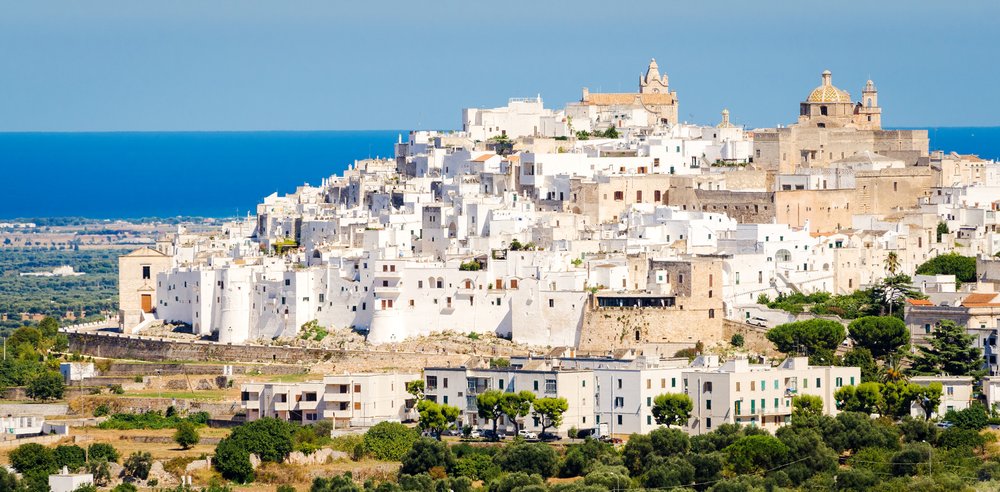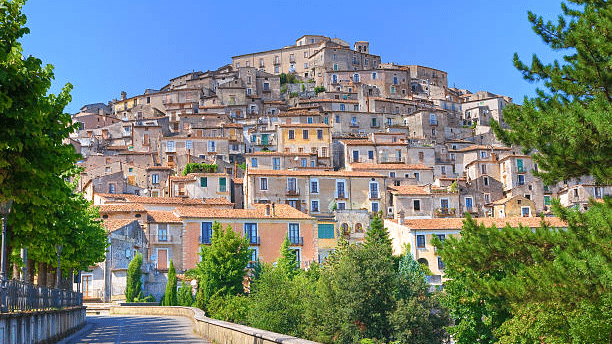In this Otranto guide, we will show this splendid old town, surrounded by a thousand years of history and by the bluest sea possible, in a few quick steps; that’s why we named it a small guide to Otranto/Apulia. Local people call it “The gateway to the Orient” or “Italy’s heaven.”

©ShutterStock
Our website includes affiliate links. So, remember that we may receive commissions when you click our links and make purchases. Please read our legal disclaimer document for more information about our Affiliate disclaimer and other disclaimers like the Fair-Use disclaimer.
About Otranto
Otranto is a historic seaside town on the Adriatic coast of southern Italy, in the region of Apulia. This small place has a lovely holiday atmosphere, making it a perfect destination for a one-day trip or a more extended stay. The picture-perfect blue waters, white buildings, and divine rocks make Otranto the frequent cover of books and articles about Puglia.
The town is in the province of Lecce (Salento peninsula) and is close to Italy’s easternmost point, known as the heel of Italy’s boot. Albania can be seen over the Strait of Otranto on a clear day.
The name Otranto is probably best known abroad for The Castle of Otranto.
Like much of Puglia, Otranto has a turbulent past. It was an important Greek and then Roman port called Hydruntum. Later, the Byzantines, the Normans, and the Aragonese ruled it. In 1480, the town was invaded by the Turks (Siege of Otranto), and 800 locals were executed for refusing to convert to Islam. The bones and skulls of the martyrs of Otranto are now stacked behind glass in the cathedral.
What Are the Best Things to Do in Otranto?
In our opinion, Otranto is worth visiting. It sits on the Adriatic Sea, gazing out across its eponymous strait towards the Balkans and Greece, a strategic position that has profoundly influenced its history. The imposing castle, thick perimeter walls, and robust towers dominate much of the town, giving way to a small port, a series of seafront promenades with excellent fish restaurants, and the town’s beautiful white sandy beach and turquoise waters. Our Otranto guide will show you the list of the best things to do when visiting this town.
Visit the Cathedral and Aragonese Castle
Firstly, explore the beautiful Romanesque cathedral, built in 1088. It features stunning 12th-century mosaics. Secondly, don’t miss the chance to see Otranto’s impressive castle, which was rebuilt after the town was freed from Turkish control in the late 15th century. More importantly, the castle offers fantastic views of the town and its coastline.
Relax on Otranto’s Beaches
We recommend spending a day at the town’s sandy white beaches. Enjoy the crystal-clear turquoise waters and beautiful surroundings. Moreover, the seafront promenade is lively, with local restaurants where you can try delicious dishes and enjoy panoramic sea views.
Visit the Saltwater Lagoons of I Laghi Alimini
The I Laghi Alimini are two lakes north of Otranto, connected and filled with various plants and animals. They attract many migrating birds, like herons and flamingos. The larger lake connects to the sea; some beaches can only be reached by walking.
Discover More Natural Landscapes
Otranto’s coastline is perfect for outdoor activities like snorkeling and sailing. Hidden coves and vibrant marine life are also available. Punto Palascia, or Capo d’Otranto, is Italy’s easternmost point. Its rocky shores, cliffs, lighthouse, and beautiful scenery make it great for coastal walks.
How do you arrive in Otranto?
The closest airport to Otranto is Brindisi, with Bari as a budget flight option. Check Skyscanner for airlines like Ryanair, Volotea, or EasyJet.
Otranto can be reached by rail, but connections outside the primary season are irregular, so we recommend renting or driving a car. In summer, “Salento in treno e bus“ links popular destinations, including buses to Santa Cesarea Terme and Laghi Alimini, operating from mid-June to early September.
Otranto is“ connected to Lecce and Santa Maria di Leuca by toll-free state highways (SS). Beware of restricted traffic areas (ZTL) in the historic center. Parking is available near the center, like a spacious lot by the Q8 gas station and Parcheggio Sant’Antonio.
We use Omio to book our train/bus tickets and Skyscanner to book flight tickets.
When to visit?
Hot sunny summers and mild winters sum up this southern part of Italy. The Adriatic Sea frames them on the east and the Ionian Sea to the west. And the swimming begins as early as May. Many bloggers advise that the best time to visit is May to June. In our opinion, however, the best time to see it is in May or June. Nature is the prettiest, and there are no crowds, so that you can admire the beautiful beaches yourself.
And last but not least, everything is cheaper than. The prices can increase in heaven in the summer, especially in August. It is not very budget-travel-friendly.
Where to stay in Otranto
Explore different accommodation options in the Otranto area, including boutique hotels, charming residences, resorts, and agriturismos. If you prefer a coastal experience, consider staying at one of the beachfront resorts. For those who want to be near the town center, numerous rooms offer stunning sea views.
When choosing an ideal accommodation, we advise you to consider your personal preferences. What do you like and prefer, and what kind of traveler are you? For instance, accommodation prices can be cheaper on the outskirts of a city; however, you will spend more time and money on transport. That’s why our guide recommends choosing your room wisely and carefully. The next thing we want to stress is safety. We constantly check which areas are safe to live in and which aren’t. After all, we are all traveling to have fun and not to be afraid to leave our rooms.
When talking about the type of travelers, we usually mean the following: Are you a solo traveler, LGBT+ traveler, a traveler with a family, etc.? For instance, if you are a solo traveler, consider hostels or other accommodations with organized social activity. But if you are an LGBT+ traveler, you will most likely want to stay in gay-friendly areas.
Lastly, when choosing your accommodation, always read the comments, owners’ reviews, etc. This will make your vacations much more pleasing and effortless.






